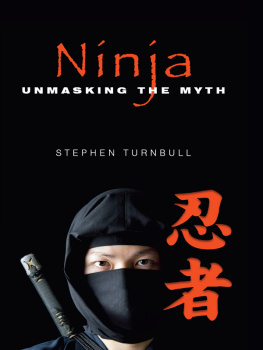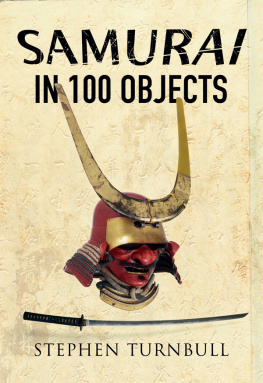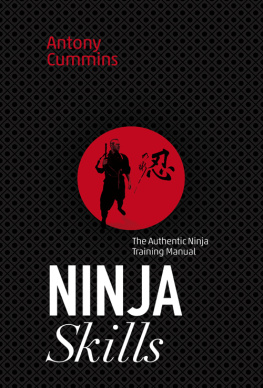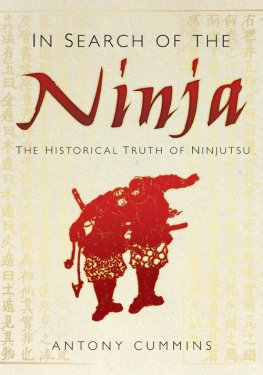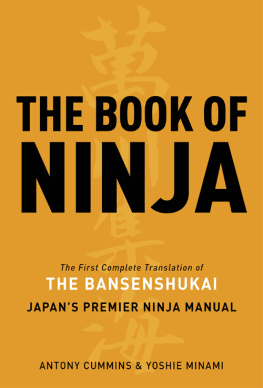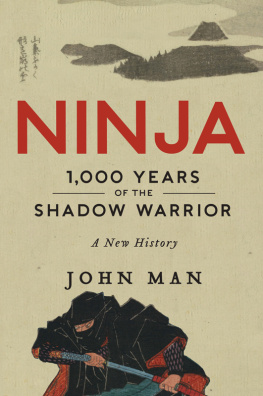
Ninja
UNMASKING THE MYTH
Dedication
This book is dedicated to Lexi.
Because no dog knows more about ninja.
Ninja
UNMASKING THE MYTH
STEPHEN TURNBULL

Frontline Books

NINJA
Unmasking the Myth
This edition published in 2017 by Frontline Books,
an imprint of Pen & Sword Books Ltd,
47 Church Street, Barnsley, S. Yorkshire, S70 2AS
Copyright Stephen Turnbull, 2017
The right of Stephen Turnbull to be identified as the author of this work has been asserted by him in accordance with the Copyright, Designs and Patents Act 1988.
ISBN: 978 1 47385 042 2
eISBN: 978 1 4738 5043 9
Mobi ISBN: 978 1 4738 5044 6
All rights reserved. No part of this publication may be reproduced, stored in or introduced into a retrieval system, or transmitted, in any form, or by any means (electronic, mechanical, photocopying, recording or otherwise) without the prior written permission of the publisher. Any person who does any unauthorized act in relation to this publication may be liable to criminal prosecution and civil claims for damages.
CIP data records for this title are available from the British Library
Pen & Sword Books Limited incorporates the imprints of Atlas, Archaeology, Aviation, Discovery, Family History, Fiction, History, Maritime, Military, Military Classics, Politics, Select, Transport, True Crime, Air World, Frontline Publishing, Leo Cooper, Remember When, Seaforth Publishing, The Praetorian Press, Wharncliffe Local History, Wharncliffe Transport, Wharncliffe True Crime and White Owl.
For more information on our books, please visit
www.frontline-books.co
email
or write to us at the above address.
Preface
I have had problems in the past with cats coming into my garden and making a mess, but last Christmas I was provided with a possible solution. It was the gift of a plastic garden gnome in the shape of a ninja. He now stands there as a menacing deterrent to feline infiltration, and it has been interesting to note that all visitors to my garden (including, I hope, the cats) identify the figure correctly as a ninja. When one considers that the word did not appear in any JapaneseEnglish dictionary until 1974, such instant recognition is a measure of how familiar the concept has become in little over half a century. Ninja: Unmasking the Myth will tell the remarkable story of how this familiarity came about, and how a wide range of stories from Japans past became transformed into a multi-million dollar cultural phenomenon that is based on the belief that there was once a time when people who dressed exactly like my garden gnome climbed into castles and set fire to them.
This belief lies at the heart of what I have termed the myth of the ninja. It also poses a considerable dilemma for an author, because a choice has to be made between explaining the popular ninja figure and merely accepting him. A serious study should show how the ninja of the movies (whose skills at the martial arts sometimes encompass the superhuman ability to fly) emerged from the realities of the past, but most popular books do not treat the topic in this way. Instead they carelessly accept fantasy as reality and retell authentic historical accounts of Japanese undercover warfare as if they were actually performed by these comic book characters, and I must confess that I have written both types of book.
First of all came Ninja: The True Story of Japans Secret Warrior Cult in 1991, a serious if flawed attempt to discover the reality behind the ninja My loyal readers would certainly be forgiven if they were to shout, Is the ninja real or not? Make your mind up!
I am, however, not the only one to have a foot planted firmly in each camp, because Japans leading authority on the ninja phenomenon has recently done the same. Mie Prefecture in central Japan includes the former province of Iga where the ninja idea first took root, and in 2012 Professor Yamada Yji of Mie Universitys Faculty of Humanities, Law and Economics risked academic scorn by setting up a research project called the Iga Ninja Culture Collaborative Field Project to investigate the lively cultural phenomenon on his own doorstep. The effort was followed in 2017 by the launch of Mie Universitys International Ninja Research Centre, for which I had the honour of delivering the inaugural lecture.
Nevertheless, both Yamada and I encourage the reader to explore more widely and seek out the truth behind the fantasy, unlike some authors who refuse to accept historical realities at all and produce supposedly serious books for adults that have more in common with the fantasy training manuals. In these books ninja are shoehorned into every conceivable historical operation that involves the slightest element of secrecy, and it is done in a way which suggests that the sources for the claims are revealed truths unearthed from secret scrolls.
One of the greatest contributions made by the Mie University initiative has been the identification of much previously unknown source material. This has revolutionised my own understanding of the subject, which now bears no relation to the situation in 1991. For my Ninja: The True Story of Japans Secret Warrior Cult I translated the historical accounts that were before me and interpreted them as I understood them at the time. My translations were largely accurate, but in the absence of the modern research now available I unfortunately allowed myself to become over-dependent on works such as Yamaguchis imaginative Ninja no Seikatsu , in which almost any secret operation in Japanese history is credited to a ninja. I had long intended to produce a revised edition of Ninja: The True Story of Japans Secret Warrior Cult because I was quite sure that one day someone would mount a serious challenge in writing. That time has now come and I am pleased that I am the one putting that challenge into words, although so much has needed to be revised that only this completely new book will suffice. Ninja: Unmasking the Myth will also extend the earlier books remit by looking at the historical and cultural phenomenon of the ninja as a whole, thereby providing some clues as to how it is possible to write contradictory books about ninja with an easy conscience.
I could not have produced this book without the personal cooperation of the staff of Mie University, and I would first like to thank Guillaume Lemagnen, who introduced me to their research team in 2014. Professor Yamada then made me very welcome and placed the departments resources at my disposal, not the least of which was supplying me with a copy of the very rare 1956 booklet Ninjutsu by Okuse Heishichir, the first post-war publication on the topic of ninja. Such information helped greatly in planning very fruitful field trips between 2014 and 2017, some of which were carried out with the help of members of staff.
Two other people have been particularly helpful in the field of the ninja as a cultural phenomenon. Jonathan Clements academic perspective on movies, martial arts, manga (graphic novels) and anime (animated films) opened many doors for me about the ninja as a fictional character.
Above all I wish to thank my dear wife Marlene, whose unwavering support sustains me throughout all my writing. In 2017 she accompanied me on a research trip to Japan and was able to experience at first hand the phenomenon of the ninja that has fascinated me for so long. I warmly welcome input from anyone who likes to get involved with ninja (apart from cats).
Next page
